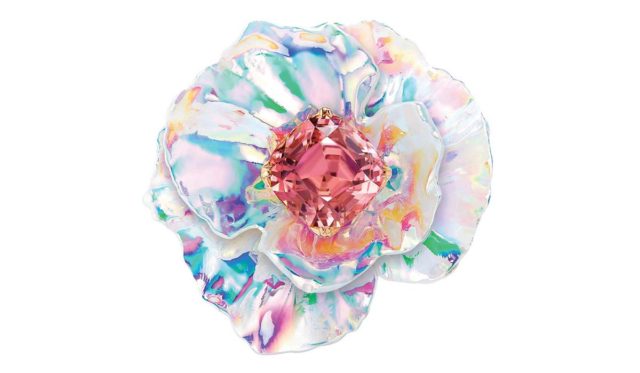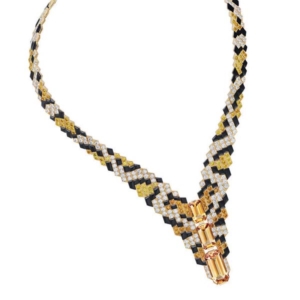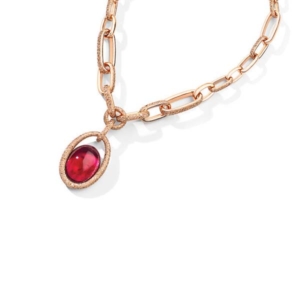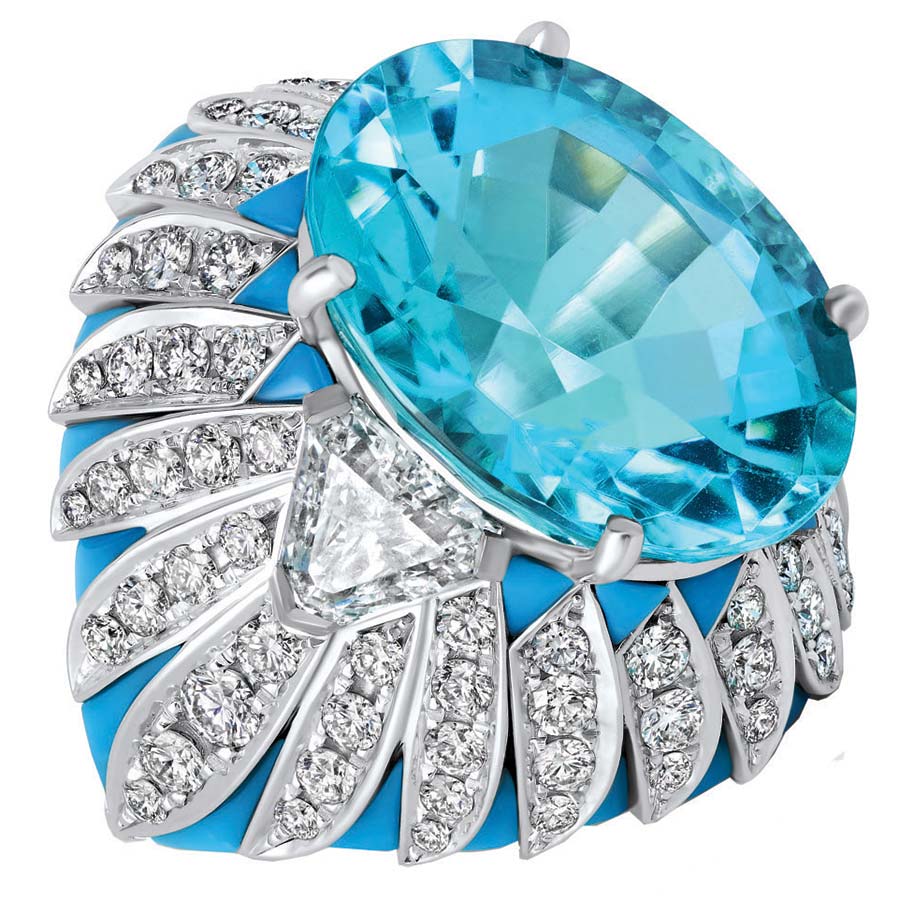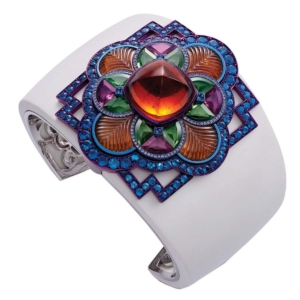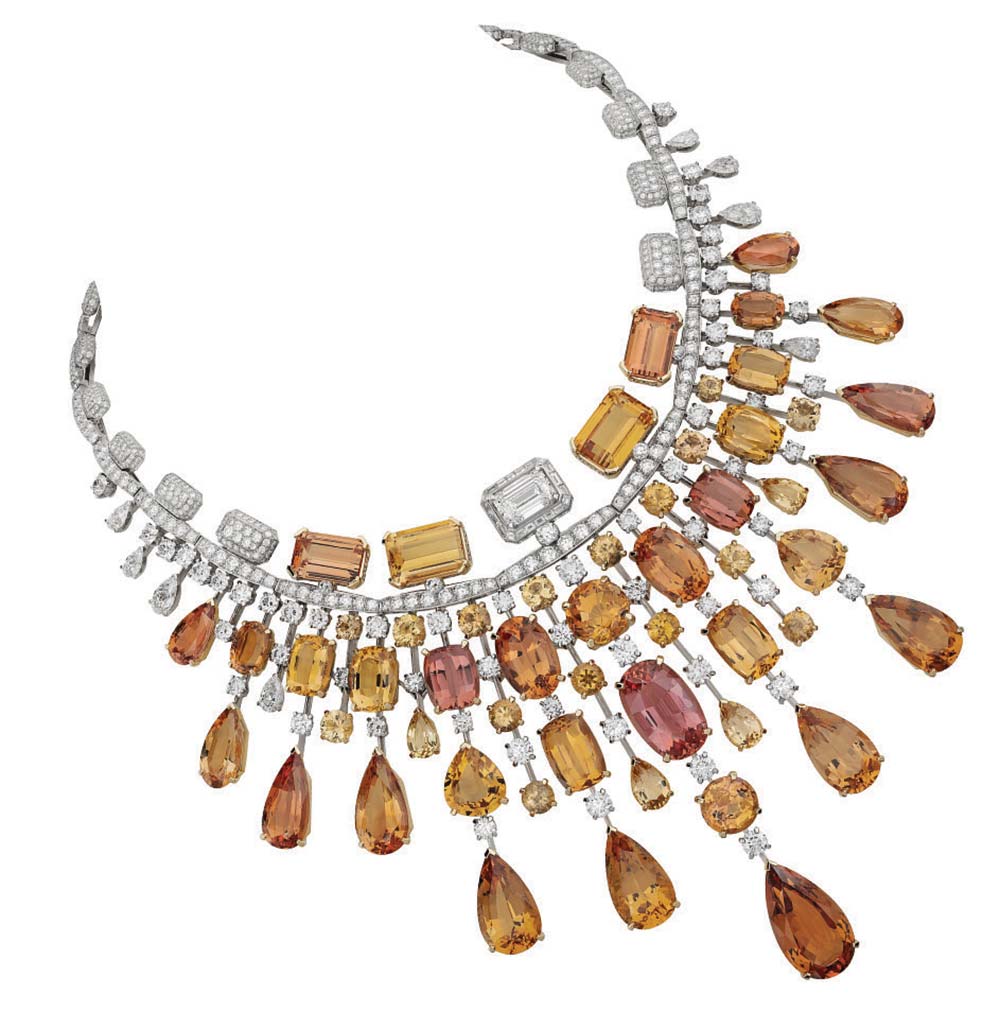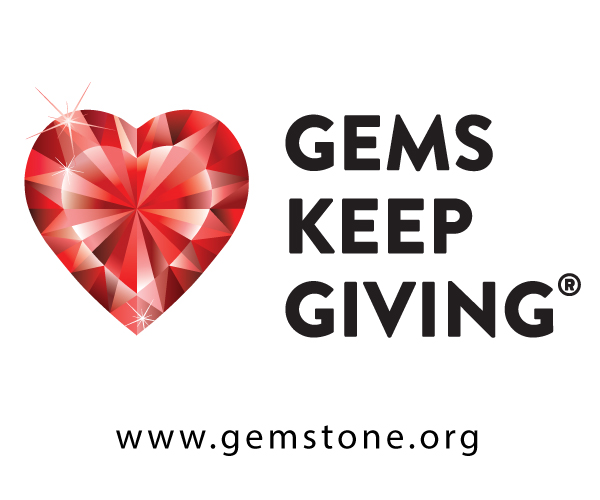Estimated reading time: 7 minutes
High Jewelry has embraced a color palette that goes far beyond the hues provided by emerald, ruby and sapphire. This article traces the recent romance between high jewels and swathes of colored gems, including some rare varieties of tourmaline, topaz and beryl.
Let’s imagine for a second that high jewelry is a purely economic choice. There’s no falling in love with a story, feeling inspired by a devilishly tricky feat of craftsmanship, or admiring a kaleidoscopic array of colors. Instead, it’s purely logical. The rarest combination of sapphires, emeralds and/or rubies, in the highest possible qualities, combined with large diamonds equals the best investment opportunity and therefore signifies which piece should be purchased.
Even as recently as ten years ago, this mentality was rife among those with the economic power to purchase high jewels from the leading houses on the Place Vendôme. While it is unlikely that anyone ever acquired a piece of high jewelry that they actively disliked, there is a certain security when spending vast sums in sticking with the top three colored stones that have appreciated throughout centuries. It may be a restricted palette, but it’s a safe one.
Times change and so do tastes. In the last five years, there has been a swift shift away from emeralds, rubies and sapphires to a much broader and more nuanced kaleidoscope of colored gemstones in high jewelry. It certainly wouldn’t be over the top to say that color and gemological uniqueness have been trending in high jewelry for the last five to seven years and they still do now, with maisons appearing to compete to gather the most impressive display of Paraiba and rubellite tourmalines, spessartite and tsavorite garnets, imperial topazes, black and white opals, spinels and beryls, combined with rock crystal, pearls, diamonds and even quartzes.
So, what has changed? There are many interconnecting factors, including popularity of strong colors in fashion; an explosion of competition; new international markets to appease; growing upper classes in countries like India, China and the Middle East; and the power of the internet and social media, which has made high jewelry more visible than ever. Stories must be told to entice consumers and imagery must be visually arresting. Color is an obvious way to attract attention and cater to plentiful tastes; jewelers can present themselves as painters and not simply purveyors of treasures for a fortunate few. Gemstone variety, in terms of mineral species, shapes and sizes, can highlight this painterly creativity and add kudos.
But this isn’t the only reason for a gemological renaissance in high jewels. Clients are more curious about gemstones, their varieties and origins. This curiosity has led to greater levels of education, fueled by the internet and various short-term gemological courses available for consumers offline. They are more careful in their jewelry choices now and wish to own something rare, exclusive and unusual. Indeed, who wants what everyone else has if a one-of-a-kind piece is on offer?
Many of the gems that have become contemporary staples in high jewelry are far rarer in Nature than diamonds, including Paraiba tourmaline and tanzanite. Similarly, it is extremely hard to find two completely identical imperial topazes or spinels for a pair of earrings, especially when attempting to match hue, tone, saturation and carat weight. As the confidence of clients continues to flourish, the race to impress them with something they’ve no knowledge of or have never seen before is intensifying. There are eight stones that have had a strong presence in high jewelry designs within the last year alone: Paraiba tourmaline, opal, imperial topaz, spinel, rubellite tourmaline, spessartite garnet, tanzanite and morganite. Here are some examples of each, starting with Paraiba, which was the focus of Bulgari’s inaugural Color Journeys series that promises new capsule collections dedicated to a specific gemstone annually. Other examples emerge in all their neon glory, such as the Azure cocktail ring with a 16-carat Paraiba surrounded by 20 carats of turquoise in the David Morris Renaissance High Jewelry offering. There’s also the Les Ciels de Chaumet Passages necklace with Paraiba in starburst arrays that lead to a 28.11-carat Australian black opal.
This takes us nicely to the theme of opals, which Jeremy Morris of British brand David Morris describes as “a rainbow of ever-changing color with a varying depth in color and form.” He continues: “This is what makes an opal such an incredibly interesting gem to work with. I am a very visual person so I would say the stone itself and its inherent beauty inspire the design.”
In 2014, Louis Vuitton presented a necklace with an 87.92-carat Australian opal combined with tourmaline, sapphire and diamonds as part of its Acte V high jewelry collection. Many fine examples have since emerged, including pieces in the Dior et d’Opales collection from 2017 and the Cartier 2020 collection, [SUR]NATUREL, where black opals with a purple hue were combined with a 71.80-carat kunzite in one memorable necklace. Recently, the Boucheron Opalescence necklace from the Holographique collection has kept the play of color alive in high jewels.
Imperial topaz has emerged as a coveted gemstone in high jewelry circles, with some examples being the Les Ciels de Chaumet Lueurs d’Orage necklace with a 37.68-carat imperial topaz, as well as the Tweed de Chanel necklace with a 20.40-carat imperial topaz Button inspired by the house’s legendary tweed fabrication.
Speaking of Chanel, its high jewelry team has also proven adept with spinels of late, which is well-demonstrated through the Collection N°5 Blushing Sillage necklace from earlier this year with spinels, rubies, garnets, sapphires and a spinel solitaire of 4.37 carats.
Italian brand Pomellato used a fantastically broad palette of gems in its 2020 high jewelry collection La Gioia di Pomellato that included tsavorite garnets, tanzanites, rubellites, pink rhodolites and orange spessartines. What makes this even more interesting is that it was the brand’s first complete high jewelry offering since its inception in 1967, which seems to suggest a bold color palette is an essential requirement for new injections into the market. And, under the spessartine garnet umbrella, there are fiery Mandarin garnets, which have been featured beautifully by Harry Winston’s Candy collection, Chopard in its latest Red Carpet 2021 collection, Louis Vuitton in its Conquêtes collection from 2017 as well as Piaget and Dior.
Finally, we have to mention morganites and kunzites that have long been favored by Tiffany & Co. As recently as its 2021 Colors of Nature High Jewelry collection, the American brand was combining colors, including blue, purple and pink spinels with purple sapphires, green tourmalines with blue sapphires, and almost every color in the rainbow in its Earth necklace, which stars a 30.17-carat cushion-cut morganite. The new Il Giardino de Buccellati high jewelry collection is also worthy of note, especially its Bouganville cocktail ring with a 25.85-carat kunzite.
There is one gemstone that was not mentioned among the top eight as it is so rare that it was unimaginable to one day see a whole high jewelry collection featuring it— Russian alexandrite. Viktor and Natalya Bondarenko, the founders of Milan-based ultra-luxury brand Rubeus fell under the spell of alexandrite and came up with the idea to create the first jewelry collection in history to showcase Ural chrysoberyls titled Eternal.
Finding jewelry-grade alexandrites of more than 10 carats after cutting and polishing may seem simply impossible. However, this did not stop the couple who collected various alexandrites, from the round cut weighing 2.52 carats to the outstanding 69.37-carat emerald cut Ural treasure—undisputed as the largest faceted Ural alexandrite known in the world. All gems were set in unique jewels designed by Frederic Mane and crafted by Jothi Seroj in France.
It’s true to say that the face of high jewelry is changing in the gemologist’s favor. Broad spectrums of colored gemstones aren’t just used to add color and interest, they’re also a fresh requirement to tempt clients who’ve “seen it all” and need to feel reawakened to new possibilities, new rarities and new ideas of what’s actually and authentically rare.
Emeralds, sapphires and rubies are still a requirement, but they are only three of the tools in an arsenal that now includes earthly, oceanic and even meteorological treasures. Waiting to see what comes next is now more exciting than ever, which is exactly how the customers on the Place Vendôme feel.
Images are courtesy of the brand mentioned.



